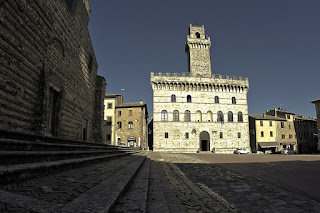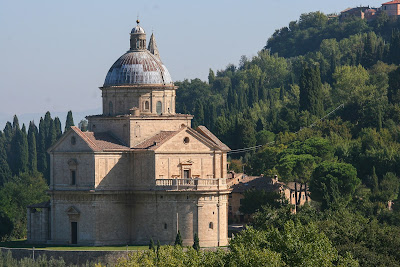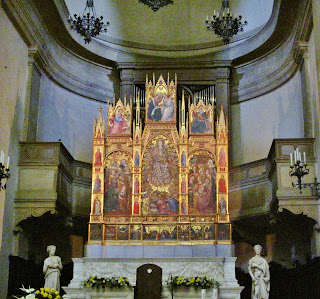Stradling, a ridge between the Chiana and Orcia Valleys, the Tuscan hill town of Montepulciano, offers visitors sweeping vistas, rustic Tuscan food and world-class wine...it's all vino & vistas

Sitting on a 2,000-foot limestone ridge near the Umbrian border, Montepulciano was said to have been founded by an Etruscan king in the 4th century BCE. The city grew in Roman times increasing in importance and has been ruled alternately by Siena and Florence over the centuries, with each ruling city leaving their distinct marks on Montepulciano. The Middle Ages saw constant fighting amongst Montepulciano's noble families until the Del Pecora family, who had ties to Santa Margherita of Cortona, became the rulers in 1390. Several centuries of peace and prosperity allowed wealthy merchants and nobles to build palaces in Montepulciano until the mid-1500s when Siena was conquered by Florence, and it's popularity declined.
 Today Montepulciano doesn't offer travellers a list of must-see sights to tick off their list; instead, an authentic experience of Tuscan food, wine and relaxed wandering.
Today Montepulciano doesn't offer travellers a list of must-see sights to tick off their list; instead, an authentic experience of Tuscan food, wine and relaxed wandering.Montepulciano is around 70 km south of Siena, 124 km south of Florence, 186 km north of Rome, but just a half-hour drive from my VBRO rental villa in Cortona. In fact, I can see the lights of Montepulciano each night from the terraced yard that overlooks the beautiful Val di Chiana. Montepulciano is easy to navigate, the newer part of town is at the bottom of the hill full of gift shops, gelaterias and restaurants gearing towards the tourist hoards. The real treasure of Montepulciano is at the top of the hill where the historical centre hides a fortress, the Duomo and palazzos for days...

Driving in Montepulciano is not a good idea. Most of the historical centre is restricted to local traffic only or zona traffic limitation. There are several easily accessible day parking lots around the edges of the town. Signs to the parking lots are well marked and numbered 1-8. If you are looking for free parking near the historical centre, try lot #8 near the Fortezza.
The inviting castle is the very top of town. Constructed in the 1200s on top of Roman ruins, the Fortezza is Montepulcianos art and cultural centre, hosting all sorts of exhibits and events for locals and tourists alike. But we decided to skip this castle and head for the main Piazza Grande.

Entering the main square, Piazza Grande, one can't help but notice the Piazza feels familiar.
This central square is dominated by the Palazzo Comunale, which looks very similar to the Palazzo Vecchio in Florence. Florence ruled this hilltown in the middle ages, and the Piazza is covered with the Medici coat of arms showing that Montepulciano was in cahoots with Florence's power & wealth. The town is absolutely gorgeous, elegant with endless views of the Tuscan countryside. I can see why Montepulciano was the Renaissance stomping grounds for the rich & famous.
Look for the Pozzo or well in the Piazza Grande. Beneath it is a giant cistern that held water for all the surrounding palaces. Above the well is the lion, the symbol of the powerful Medici family of Florence. The lions hold up the Medici coat of arms, kind of like a paid political advertisement of the Middle Ages~ "This clean water brought to you by The Medicis...you're welcome."

For 360 degree views of the Tuscan countryside, a trip up the tower of Palazzo Comunale. To climb the tower, head into the palazzo and up the stairs on the left. On the second floor is the cashier office (open 10am-6pm) and it a €5 entrance fee. From the top of the tower, Montepulciano flows down the hill like a silk veil into the lush Tuscan farmland- so breathtakingly beautiful. A photographer could spend days here! You also get views of the square below with Palazzo de' Nobili-Tarugi in its arcaded Renaissance splendour, the Duomo with its unfinished facade, Palazzo Contucci. The Contucci palace was built by del Pecora family whos son hid Saint Margherita of Cortona away as his mistress, and is surrounded by many other stunning Renaissance palaces in the Piazza.
 |
| Photo of San Biagio by Klaus Stebani |
From your perch on the top of the tower, you can see the domed church on San Biagio below. This domed masterpiece was the work of Renaissance artist Antonio da Sangallo who also designed Palazzo Tarugi. Both of these elegant buildings are built out of locally quarried travertine marble. Bramante, the master architect, spent time in Montepulciano, and the dome of San Biagio influenced his design of St. Peter's dome at the Vatican. A walk down to San Biagio along Via di San Biagio from San Francesco church is delightful.

A quick peeked into the Duomo on the Piazza Grande for a look at the art is worth the stop. The church was supposed to be covered by Travertine marble, but the town was cut off from funds when Siena was overpowered by Florence. To the left, when you enter the Duomo, is the Early Renaissance work by Sienese master Andrea Della Robbia. The "Alter of Lilies" in the baptismal font is a gorgeous glazed terracotta piece that is all golden & gothic.

Behind the altar of the church is a three-panel retable by Sienese early Renaissance artist Taddeo di Bartolo. Painted in 1401, this altarpiece includes a self-portrait of the artist as one of the apostles. This panel was painted in-situ, which means this work of art is displayed in the place that it was intended to for-not a museum. It's my favourite way to appreciate the art the way the artist intended it to be experienced.
Other treasures in Montepulciano must be experienced, but not of the visual sense...
 |
| Corso of Montepulciano |
 Next, I headed downhill and ran a gauntlet of wine stores, passing many delightful artisan shops and found a quiet little "trattoria." Sitting outside a tiny piazza overlooked by a whimsical clocktower on top of Palazzo Bucelli, I had a very memorable lunch. It was a hot afternoon in the mid-September sun, so I ordered "Panzanella" which is a type of Tuscan traditional dish of bread salad with tomatoes and olive oil. Along with the salad, I had a "mezzo" litre or half-litre of local white wine, Montepulciano Bianco. This local wine is the colour of pale straw; light, sweet and crisp-perfect for a summer lunch one a patio. I wish I had picked up a bottle to bring home.
Next, I headed downhill and ran a gauntlet of wine stores, passing many delightful artisan shops and found a quiet little "trattoria." Sitting outside a tiny piazza overlooked by a whimsical clocktower on top of Palazzo Bucelli, I had a very memorable lunch. It was a hot afternoon in the mid-September sun, so I ordered "Panzanella" which is a type of Tuscan traditional dish of bread salad with tomatoes and olive oil. Along with the salad, I had a "mezzo" litre or half-litre of local white wine, Montepulciano Bianco. This local wine is the colour of pale straw; light, sweet and crisp-perfect for a summer lunch one a patio. I wish I had picked up a bottle to bring home.
If you can stay in Montepulciano into the evening, or better yet, overnight, you will find the town makes an almost audible sigh of relief as the day-trippers return to the big cities. As the sun sinks below the sun-drenched Tuscan hills, the shops close, and locals relax and full restaurants spill out into the piazzas. This is the time of day when you forget Montepulciano's history and the sights and just enjoy the vibe of the town and being in the moment. Whether you are a wine connoisseur, an architecture devotee or just like beautiful scenery, Montepulciano has it all!





No comments:
Post a Comment